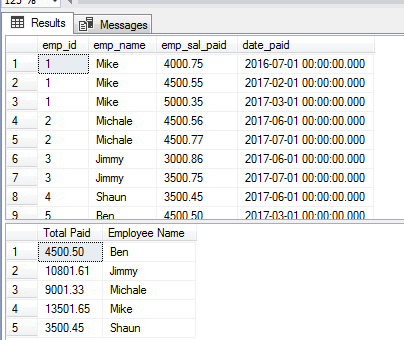Winner of Best BI Software for SQL. Get the Most out of Your Data. Watch the Free Tableau Video Demo! Move Forward With Confidence. Connecting With The Data Community.
To get the managers and their direct reports, you use the GROUP BY clause to group employees by the managers and use the COUNT function to count the direct reports. For more information about search conditions and predicates, see Search Condition (Transact- SQL ). The text, image, and ntext data types cannot be used in a HAVING clause. SQL GROUP BY Examples ProbleList the number of customers in each country. Only include countries with more than customers. The GROUP BY with HAVING clause retrieves the result for a specific group of a column, which matches the condition specified in the HAVING clause.
SQL HAVING with SUM function example. Mostly HAVING is used when you have groups of data and WHERE is used when you have data in rows. Using group by and having clause - Stack. AVG(titles.price) FROM titles INNER JOIN publishers ON titles. The resulting SQL statement might look like this: SELECT titles.
Where vs having clause SQL? When to use having in SQL? Leverage Existing SQL Skills In NoSQL With N1QL JSON Queries. We can use aggregate function with HAVING clause not by WHERE clause e. WHERE clause eliminates the record tuple by tuple HAVING clause eliminates entire group from the collection of group. A HAVING clause in SQL specifies that an SQL SELECT statement should only return rows where aggregate values meet the specified conditions.
It was added to the SQL language because the WHERE keyword could not be used with aggregate functions. The HAVING command is used instead of WHERE with aggregate functions. The following SQL lists the number of customers in each country. In contrast the WHERE clause is applied to individual rows, not to groups. It is typically located near or at the end of the SQL statement.

The SQL Having clause is used to filter summary from a GROUP BY. It specifies the search condition for the group or aggregate. It is mostly used when a GROUP BY is present, if one isn’t there is an implicit single aggregated group. Group functions cannot be used in WHERE Clause but can be used in HAVING clause.
This is similar to WHERE condition but is used with group functions. In this blog, we will discuss how to work with GROUP BY, WHERE and HAVING clause in SQL and explain the concept with an example in a simple way. I hope this is very useful for beginners and intermediate to help them understand the basic concept. The WHERE clause places conditions on the selected columns, whereas the HAVING clause places conditions on groups created by the GROUP BY clause. If there is no GROUP BY clause, the HAVING clause is applied to the entire result as a single group.
This Oracle tutorial explains how to use the Oracle HAVING clause with syntax and examples. The Oracle HAVING clause is used in combination with the GROUP BY clause to restrict the groups of returned rows to only those whose the condition is TRUE. Combining the two: WHERE and HAVING.
Secon the HAVING clause filters the sales orders whose net values are less than or equal to 2000. SQL Server HAVING clause with MAX and MIN functions example.
Nincsenek megjegyzések:
Megjegyzés küldése
Megjegyzés: Megjegyzéseket csak a blog tagjai írhatnak a blogba.